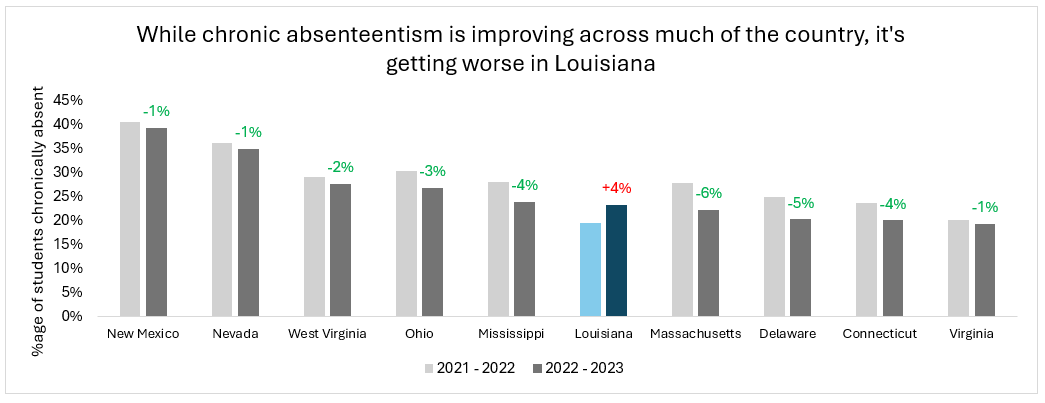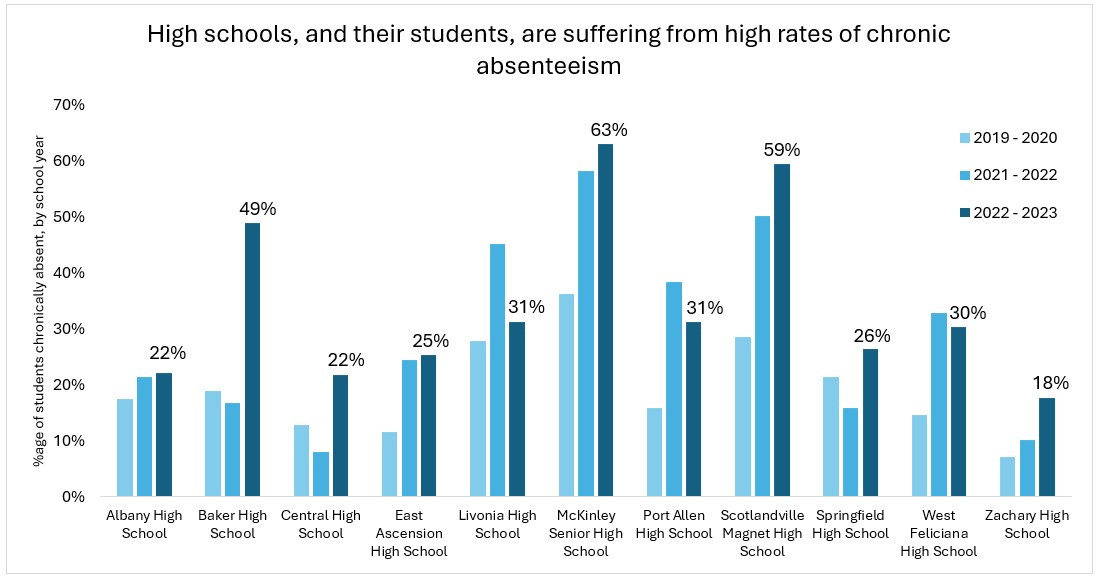Let the kids sleep!
By pushing back school start times, Louisiana has a rare chance to use evidence-based policy to address a range of issues facing our students and schools
There are more than 125,000 students enrolled in K-12 public schools across the Capital Region and about 51,000 of them were truant last year1. You read that right – 2 out of every 5 students, or 41% - were considered truant, meaning they had at least 5 unexcused tardies or absences in a semester during the 2022- 2023 school year.
When truancy goes unchecked, it can lead to chronic absenteeism. Chronically absent students, or those who miss at least 15 school days per year2, experience more behavioral issues, are less likely to be reading on grade level, and are more likely to drop out3. Later in life, they’re more likely to have an income below the poverty line, to have poorer health outcomes, and to be involved in the criminal justice system4. More than 26,300 Capital Region students were chronically absent last school year. That’s up from 24,000 the prior year, a nearly 10% increase.
While chronic absenteeism continues to worsen here, it’s improving across much of the country. Among the 15 states that EducationWeek analyzed in a study last year, Louisiana was the only one in which chronic absenteeism got worse between the 2021–2022 and 2022–2023 school years.
Research has found that high schoolers suffer some of the highest rates of chronic absenteeism. Considering that excused absences are included in chronically absent calculations, some of this is due to school-sponsored activities like sports, band, and other extracurriculars. But high schoolers are also more autonomous than younger students. Many are responsible for getting themselves to school. For many high schoolers, the keys to their education are in their own hands.
High schools across the Capital Region are suffering from high rates of chronic absenteeism, and it’s only gotten worse post-COVID. It doesn’t matter whether the school is urban, suburban, or rural, or whether it primarily serves high-income or low-income students – almost all are struggling to get kids to school. Even at Baton Rouge Magnet High School, the fifth highest-rated school in Louisiana in 2023, 1 out of every 10 students was chronically absent last year.
What can we do?
Students don’t get enough sleep, and research has shown that, when students don’t get enough sleep, they’re less likely to attend school. Studies, including a list of those compiled by the American Psychological Association, have shown that schools shifting to later start times see increased attendance, better academic performance, and, unsurprisingly, fewer sleepy kids in class. The list of benefits goes on, but the logic is simple: give students more time to sleep (and they do, in fact, sleep more when given the chance) and they’re more likely to both attend school and be attentive while there.
Improvements in chronic absenteeism and associated academic gains are but one benefit of pushing back school start times. One economic model projects widespread economic gains if school start times are pushed back across the country, including a $1.2 billion increase to Louisiana’s GDP over the next ten years. Other research points to potential reductions in juvenile crime: later start times mean later end times and when students, especially teenagers, get out of school later and have fewer idle hours in the late afternoon/early evening, juvenile crime is likely to come down. So while other solutions have been implemented across the country, such as Connecticut’s usage of COVID money to stand up a home visit program, these solutions are often costly, temporary, and unlikely to address a serious root cause of chronic absenteeism and other school- and youth-related issues: lack of sleep.
Pushing back school start times, like any other change from the way things have traditionally been done, comes with some kinks that need to be worked out. Questions have been raised about transportation (what will the cost of new bus schedules look like?) and extracurriculars (if students get out of school later, how will they have time for sports or clubs?) These, along with “change” generally, have been among the most vocalized concerns. While these questions are valid, they should not, we hope, overshadow the academic, behavioral, and attendance-related benefits that have been demonstrated in actual schools that have pushed back start times.
Two states, Florida and California, recently passed bills making sure middle schools start no earlier than 8 a.m. and high schools no earlier than 8:30 a.m. Louisiana House Bill 725 aims to do the same thing in this state. Acknowledging that it will take some time to answer the questions mentioned above, the bill affords school leaders and administrators two full academic years to plan before the legislation kicks in during the 2026-2027 school year. This is a chance to use good policy, backed by extensive research, to do right by our students. Let the kids sleep!
Student counts in this analysis come from Louisiana Department of Education and include all public school students enrolled in the 12 regional school districts and all Capital Region Type 1 charter schools
Includes both excused and unexcused absences
https://ies.ed.gov/ncee/edlabs/regions/midatlantic/app/Blog/Post/5
https://www2.ed.gov/datastory/chronicabsenteeism.html#four







